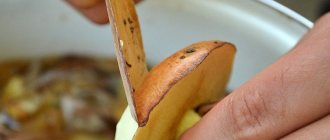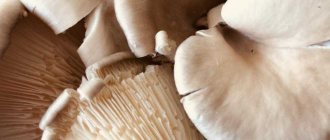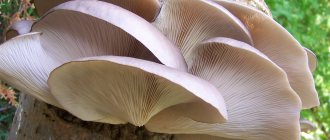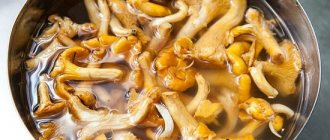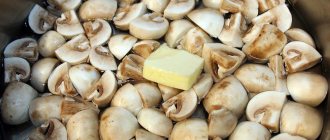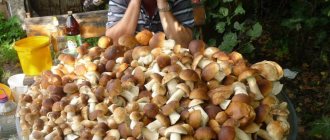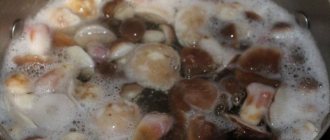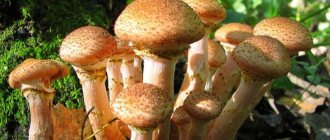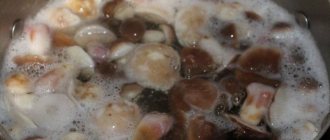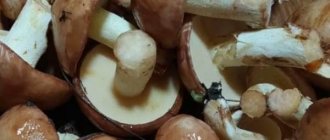It is better to choose fresh and young mushrooms for cooking, just like other products. They can be boiled, fried, stewed, added to soups, salads, main courses and served as an independent dish. Mushrooms are usually very easy to cook. But even here there are nuances. For example, should mushrooms be boiled before frying? Let's figure it out.
Pros and cons of pre-cooking mushrooms
The need for cooking is due to the fact that during growth, mushrooms absorb toxins from the soil. Large specimens in this regard are more dangerous than small ones.
The point of pre-heat treatment is to remove all harmful substances from the mushrooms
In addition, large mushrooms also accumulate their own waste products, which makes them hazardous to health.
An undeniable advantage of pre-heat treatment of mushrooms is the reduced risk of poisoning. The only downside is the deterioration in the taste of the product, but this is only possible if it is cooked for too long.
Selection in store
By choosing champignons in the store, you make your life easier because you don’t have to pick the mushrooms yourself and you can be sure that they were grown and picked by professionals. But if you buy fresh champignons, you should understand that during transportation the mushrooms could be damaged and spoiled. It doesn’t matter how you process the champignons before cooking, it’s better to play it safe and choose only high-quality mushrooms. To do this, when buying champignons, you should use our set of rules.
First of all, choose small mushrooms. And the question here is not only their ability to absorb, young ones are denser, and they also look more attractive on the plate.
Inspect the appearance of the mushroom; a high-quality body should not have blackening or dents. Its color is usually white or pinkish. The cap is velvety to the touch, the fungus has a matte shine.
The cap should fit tightly on the stem; to determine whether it is a young mushroom or not, look under it; the plates of an old mushroom will be dark, while those of a young mushroom will be pleasant and creamy.
Of course, the product should not have any foreign odors other than its natural one.
Having bought mushrooms in a store, you can store them at home for no more than 5–7 days, at a low temperature and under no circumstances in a plastic bag.
How long does it take to cook fresh champignons?
This will directly depend on the size of the champignon. Medium-sized mushrooms, whole, need to be cooked for 8-20 minutes. Shredded champignons are cooked for 3-10 minutes. The countdown time begins after the water with mushrooms boils.
How long does it take to cook frozen champignons?
Frozen champignons need to be removed from the packaging and defrosted. After the water boils, cook the mushrooms for 8-12 minutes.
How long to cook champignons in soup?
Champignons cook quite quickly. You can add mushrooms to the soup after the potatoes have boiled. And cook for 6-7 minutes.
How long to cook mushrooms in a slow cooker?
Champignons are very watery mushrooms. Therefore, in a slow cooker, champignons are cooked in their own juice. Cook in the “Simmer” mode for 15 minutes.
Boletus
Boletus is a mushroom with a characteristic hemispherical cap, colored in the colors of fallen aspen leaves. Its leg is dense and stocky. In nature, boletuses can be confused with gall mushroom.
Boletus mushrooms need to be cooked for 20 minutes from the moment they boil in the pan. In a slow cooker they are cooked for 30 minutes in the “stew” mode. Try to cook mushrooms within 2 days after picking.
- Clean the boletus from grass, pine needles, and dirt. Rinse in cold water. If you soak them in cold water for an hour before doing this, the dirt will come off easier.
- Pour water into the pan, add mushrooms. Boletus broth is used for soups and sauces. In this case, you need to measure the amount of mushrooms based on the recipe. So, for an ordinary soup, 300 g of boletus per 2 liters of water is enough.
- Place the pan over medium heat, add salt, add mushrooms, and bring to a boil. Next, cook for 20 minutes.
- Skim off foam during cooking.
- Remove the finished boletuses with a slotted spoon and place in a colander to drain.
- Strain the broth through a sieve or cheesecloth, then use for soups and marinades.
How long to cook porcini mushrooms
Before heat treatment, boletus mushrooms must be properly prepared. That is, they must be cleaned. To do this, the stem and cap are first cleaned of large particles of debris: remnants of forest soil, adhering leaves and pine needles.
Note: Next, it is advisable to soak the product in cold water for 1 hour, but if you are going to dry the boletus mushrooms, it will be enough to simply peel them. In this case, you cannot wash or soak them.
Soaking helps to naturally remove small debris from hard-to-reach places. After this, you need to remove all the darkened pulp, and in old specimens you should additionally remove the thin skin from the stem. Next, all that remains is to cut the mushrooms into pieces of the desired size. Small boletus mushrooms can be cooked whole (Figure 1).
Figure 1. Preparation for heat treatment
Cooking porcini mushrooms is a mandatory step in their preparation. While there are some general principles to this process, the duration and method of cooking will largely depend on how you cook them next. So that you don’t have any questions regarding preparation, we will look at each option in more detail.
How long to cook before frying
Boletus mushrooms belong to the highest category, that is, they contain many useful substances, have a pleasant characteristic aroma and a pronounced taste. However, this does not mean that you can skip the stage of thorough heat treatment.
Often they prefer to fry them with onions and then add them to boiled potatoes or porridge. To make the flesh tasty and dense, boletus mushrooms must be properly boiled before frying. To do this, the prepared product is poured with water so that it completely covers the pulp. Place the pan on the fire and bring the liquid to a boil. Foam will form on the surface: be sure to skim it off with a slotted spoon, then add salt and spices to taste and continue cooking until done. Typically, this process takes about 30 minutes for small specimens, and 45 minutes for large ones (Figure 2).
Figure 2. Preparing for frying
Since in the future the product will undergo additional heat treatment in the form of frying, it makes no sense to change the water or cook the mushrooms longer. Overcooked pulp will lose density and simply fall apart during frying.
How long to cook porcini mushrooms for freezing
Freezing is an excellent option to preserve delicious boletus mushrooms during the winter and be able to include them in your favorite dishes at any time (Figure 3).
Note: Despite the fact that some housewives prefer to freeze boletus mushrooms raw, it is better to boil them first. The fact is that such pre-treatment will help not only reduce the cooking time in the future, but also preserve the density, taste and aroma of the pulp.
If you plan to freeze them, the first step is to sort them by size. Large specimens are cut into pieces, while small and medium ones can be boiled and frozen whole. As in the case of processing boletus mushrooms before frying, they are boiled only once before freezing, and it is better to do this in different pans, since small pieces cook much faster than large ones.
Figure 3. Cooking before freezing
Fill the prepared and sorted boletus mushrooms with water and bring to a boil. When the mixture boils, remove the foam from the surface of the liquid, add salt and your favorite seasonings to taste and continue cooking over medium heat. For the pulp to cook, it will take 35 minutes for small pieces and whole mushrooms, and 45-50 minutes for large specimens.
How much to cook for soup
Mushroom soup is considered one of the most delicious dishes, and if you add wild porcini mushrooms to it instead of ordinary champignons, its taste will become completely exquisite.
Naturally, to prepare such a soup, you need to properly prepare the main ingredient - boletus mushrooms. According to the rules, they are added to the soup dried or pre-boiled, but a frozen product can also be used (Figure 4).
To pre-boil a product to add to soup, you must:
- Peel fresh boletus mushrooms and rinse them under running water.
- Place the prepared product in a saucepan and fill with clean water so that it completely covers the pulp.
- You need to add salt to the water. On average, 2-3 liters of water require a level teaspoon of salt.
- Bring the liquid to a boil over high heat, and then reduce the heat so that the water does not boil too intensely.
- After boiling, the cooking time for fresh boletus is 35-40 minutes, and for dried boletus – 20 minutes.
During cooking, foam will constantly form on the surface of the liquid, which must be removed. The mushrooms will be ready when they settle to the bottom of the pan. After this, they can be thrown into a colander, allowed to drain off any remaining moisture and added to the soup.
Figure 4. Cooking boletus mushrooms for soup
When such preparatory activities are completed, you can begin to directly prepare the soup. When using pre-boiled fresh boletus, they are added to the soup about 20 minutes before the end of cooking. If you use frozen ones and did not have time to defrost them in time, you can add them 30 minutes before the end of cooking, along with the potatoes.
How long to cook dried porcini mushrooms
As a rule, dried boletus mushrooms are used as a separate ingredient for preparing stews, soups or casseroles. Unlike fresh ones, dried ones must be properly prepared for heat treatment (Figure 5).
First, they need to be soaked in water for 2-3 hours. This will not only allow the pulp to swell, but also remove any small particles of debris that may have accumulated on the surface. Secondly, it is advisable to pre-boil dried boletus mushrooms before adding them to dishes. To do this, fill them with water, add a little salt and cook over medium heat until tender within 20 minutes after boiling.
In most cases, it is recommended to use the same water that was used for soaking, since it is this liquid that gives the finished dish a rich taste and aroma. However, if you notice large particles of debris on the surface, it is better to replace the fluid.
The above recommendations are relevant if you need to add dried mushrooms to the finished dish already pre-boiled. But, if you are stewing potatoes or stews, you can add the dried mushrooms directly to the pan immediately after soaking. During the cooking process, the pulp releases juice, which gives the finished dish a characteristic taste and aroma.
How long to cook for marinating
Pickling is a process in which the density of the pulp, taste and aroma of boletus mushrooms are preserved with the help of preservatives - vinegar and citric acid. With this method of harvesting, boletus mushrooms must undergo a full cycle of heat treatment, since during pickling the pulp is simply soaked in brine. Accordingly, they must be completely ready for use.
There are several options for cooking before marinating. The first is that the boletus mushrooms are boiled separately, and only after they are completely cooked are they poured with brine and sterilized. According to the second option, they are boiled together with brine. In terms of taste, preference should be given to the second option, since with such preparation the workpiece acquires a rich taste and aroma.
Regardless of the chosen method, boletus mushrooms must be cooked so that their pulp is completely cooked, and this depends on the size of the fruiting bodies. For example, small mushrooms, whole or pieces, are boiled for about 35 minutes from the moment of boiling. Large specimens require much more time to prepare: they are cooked for 45-50 minutes after the brine boils.
Figure 5. Preparing for marinating
You can determine that the mushrooms for pickling are fully cooked by several signs. First, the fruiting bodies must settle to the bottom. Because of this feature, you need to periodically stir them in the pan so that they do not stick to the bottom. In addition, you need to constantly remove the foam that has formed on the surface of the liquid.
Secondly, the color of the brine also serves as a sign of readiness. It should become completely clear, although the mixture will appear cloudy when mixing the ingredients directly.
Regardless of the chosen method of cooking for pickling, it should be taken into account that for long-term storage at room temperature or in the refrigerator, it is advisable to sterilize such a workpiece. This process will destroy pathogens, but at the same time preserve the taste and smell of forest boletus. On average, the duration of sterilization is 30-40 minutes for half-liter jars, and 45-50 minutes for liter jars.
How long to cook porcini mushrooms for pickling
The preparation of fruiting bodies before salting is carried out in a similar way. By the way, salting boletus mushrooms is considered one of the best ways to preserve this product during the winter.
As in the case of pickling, before salting, boletus mushrooms must undergo complete heat treatment and be completely ready for consumption. Only after this they are salted into jars or barrels. Naturally, before this, the mushrooms are sorted by size, cleaned, and large specimens, if necessary, are cut into pieces. Slicing before salting not only helps make the pieces more uniform, but also inspects the inside of the flesh for worms.
They are then boiled in lightly salted water. There is no need to heavily salt the liquid, since during the pickling process in jars the pulp will be saturated with aromatic brine. On average, for 2-3 liters of liquid you will need a level teaspoon of table salt. If you are afraid of oversalting the product, you may not add salt to the water at all. In addition, experienced mushroom pickers advise boiling large and small mushrooms in separate containers. Because they have different cooking times, you run the risk of overcooking small pieces or undercooking large ones. In the first case, the product will lose its taste, and in the second, it may even deteriorate.
To properly prepare porcini mushrooms before salting, they are sorted, washed under running water and cleaned. Small specimens can simply be cleaned of large debris, while large ones need to additionally remove the thin skin from the stem. If you are not sure about the purity of boletus mushrooms, you can soak them in clean cold water for several hours. This will remove even the smallest particles of debris from the pulp. After this, the mushrooms are boiled in water whole or in pieces. Cooking time directly depends on the size of the fruiting bodies. Small ones are cooked no more than 35 minutes after boiling, and for large specimens this time is 45-50 minutes. During the process, it is necessary to stir the product so that it does not stick to the bottom of the pan, and also to remove the foam formed on the surface, as it can spoil the taste of the finished dish.
If you are interested in the details of boiling porcini mushrooms before preparing various dishes, we recommend that you watch the video, which shows not only the secrets of the heat treatment of boletus mushrooms, but also the nuances of cleaning them and preparing them for cooking.
You will find useful tips on heat treatment of porcini mushrooms in the video.
boletus
This fungus prefers to settle at the roots of birch trees alone or in small groups. Has a hemispherical hat. After rain it becomes sticky and covered with mucus. The boletus grows on a fleshy stalk covered with dark gray scales. In nature, it can be confused with false boletus, but the latter's broken cap will begin to turn blue after a while.
We invite you to read Why you need to register a country house
The cooking time for boletus mushrooms in a saucepan is 40–50 minutes. In a slow cooker they are cooked for 30 minutes in the “baking” mode.
- Thoroughly clean the mushrooms from dirt and debris, remove the base of the stem, and place in a container with clean water.
- Rinse clean boletus mushrooms under running water.
- Place the mushrooms in a saucepan, measure out twice as much water, add salt (1 tbsp per 1 kg of boletus mushrooms), bring to a boil over medium heat.
- After boiling, drain the water, add fresh water, and simmer over low heat for 40–50 minutes. Skim off foam during cooking.
- The finished boletus mushrooms will sink to the bottom. Remove them with a slotted spoon or drain them in a colander.
How long to cook mushrooms
Before eating, they must be subjected to heat treatment. Therefore, you need to know how to cook correctly and how much time you will have to spend on it. It all depends on whether they are fresh or frozen and what you are going to do next. You need to cook for 5-6 minutes if you cut them into pieces.
Cooking whole mushrooms is a longer process and takes 10–15 minutes. Readiness is determined in a simple way: if they sank to the bottom of the pan, it means they are cooked. Every minute of cooking also plays a role. If you overcook them, they will become soft and tasteless, and undercooked mushrooms will quickly turn sour.
Before frying
Champignon has an exquisite taste regardless of whether it is fried, pickled or baked. This mushroom is suitable as a side dish for meat dishes, it is eaten together with vegetables and as an independent dish. It is recommended to cook wild champignons before frying, as they absorb harmful substances and can be poisonous. Therefore, they must be boiled to remove toxins. Those purchased in the supermarket are grown artificially.
Consequently, they do not contain substances harmful to humans, so there is no need to boil them before frying . In general, frying champignons does not involve preliminary heat treatment. The main thing when purchasing is to make sure that the product offered is fresh. Boiled is added to a dish only if the recipe requires it. If during the cooking process it is necessary to preserve the volume of the product, they are also pre-boiled.
Frozen
Frozen champignons also spoil if stored improperly. The temperature of the freezer must be maintained within -18°C. If they begin to darken and spots appear on them, it means that the freezing was carried out in violation of the rules. To keep mushrooms longer, only fresh products should be frozen.
Before cooking frozen champignons, they must first be thawed and rinsed well under running cold water. First, you need to boil water in a saucepan, and then pour the defrosted and washed mushrooms into it. The process of cooking frozen champignons takes approximately 7–10 minutes. The water in which the mushrooms are cooked should be salted.
For the salad
Various salads are often prepared with mushrooms. Preparing champignons for salad consists of several stages:
- They are washed thoroughly so that no dirt remains. If the leg cannot be washed, its edge must be cut off with a knife.
- Take a saucepan with cold water, put it on the fire and bring it to a boil. First add salt, allspice, bay leaf, and a pinch of citric acid (it will prevent them from darkening).
- When the water boils, throw the champignons into it, then reduce the heat and after 7 minutes they are ready.
- Once cooked, the liquid is drained using a colander before being cooled.
- Next, you need to let them cool, then cut them into pieces of the desired size and add them to the salad.
Champignons prepared for salad can be stored for some time by putting them in a jar and pouring the marinade in which they were cooked. When using, just drain the marinade; it is not necessary to rinse the mushrooms.
Important! The cooking time is relevant for store-bought mushrooms; forest mushrooms can be cooked at 1.5
–
2 times longer.
For soup
Any housewife can cook homemade mushroom soup with champignons. The main ingredients of this dish are potatoes and mushrooms.
Ingredients needed for cooking:
- water: 1.5 l;
- fresh champignons: 5-6 pieces;
- potatoes: 2 pieces;
- carrot: 1 piece;
- onion: 1 piece;
- sunflower oil: 2 tablespoons;
- greens (parsley, dill): to taste;
- salt: to taste.
Cooking method step by step:
- Finely chop the onion and cut the carrots into strips.
- Fry vegetables in a saucepan in vegetable oil.
- Chop the mushrooms coarsely, add to the vegetables and fry for 3 minutes.
- Peel raw potatoes, cut into cubes, and add to the pan with mushrooms and vegetables.
- Pour boiling water into a saucepan with vegetables and cook until tender.
- At the end, add salt to taste, add finely chopped herbs.
The dish is ready and can be served. If you want the soup to be transparent, do not allow the liquid to boil strongly during the cooking process. Do not keep the dish on the fire for a long time, otherwise the potatoes will boil and turn into mashed potatoes. If you don’t plan to cook the soup right away, you can boil the mushrooms and freeze them, and then use them. Boiled, frozen product can be stored in the freezer for a long time.
Did you know? The mushroom got its name from the French, who were the first to try and appreciate its taste. It was champignons that were the first to be grown under artificial conditions, so they are available all year round.
This mushroom tastes good and goes well with anything in your refrigerator. People also call it “pecheritsa”. Once upon a time in forest areas it was not collected among other mushrooms, considering it “dung”, since it grew mainly on horse manure. But now everyone appreciates its taste.
Chanterelles
Chanterelles are funnel-shaped mushrooms with a dense, fleshy cap. In young specimens it is almost flat, with a rolled edge. The plates are sparse, branched, thick, descending along the stalk. In the old days, mushrooms were called fox mushrooms, that is, yellow ones. In nature, they can be confused with false chanterelles.
Real chanterelles are never wormy and do not break. But they are bitter, so they are soaked in milk before cooking. Cooking time is only 20 minutes.
- Thoroughly clean the chanterelles of debris and rinse in a colander.
- Soak in cold water or milk for 1–1.5 hours.
- Place the chanterelles in a saucepan and cover with cold water (1 cup per 2 cups of liquid).
- Bring to a boil, cook over medium heat until tender (20 minutes).
- Skim off foam during cooking.
- Place the finished chanterelles in a colander.
When preparing as a separate dish, salt them during cooking. Accordingly, you don’t need to do this if you plan to put chanterelles on a salad or roast, which is supposed to be salted during the cooking process.
How much and how to cook wild mushrooms?
Mushrooms are a product that you either love or hate. Some people think that mushrooms are a good substitute for meat. And some believe that mushrooms are not digestible at all in our body. Today we will answer a very important question: how much and how to cook wild mushrooms?
How long to cook wild mushrooms?
It will be easy to answer this question if you know the types of mushrooms you are going to cook. There are mushrooms that must be peeled. And some are soaked and then washed thoroughly. So each class of mushroom is cooked in its own way. Below you will find the cooking times for the most popular types of wild mushrooms. The time indicated is after the water has boiled.
- How long to cook porcini mushrooms? 40 – 45 minutes. Rinse well before cooking.
- How long to cook honey mushrooms? Be sure to clean it before cooking. Total time 35 minutes. First, cook for 10 minutes and pour out the water. Next, add water a second time and cook for another 20 minutes.
- How long to cook butter? Be sure to clean it before cooking. Total time 30 minutes. First, cook for 5 minutes and pour out the water. Next, add water a second time and cook for another 25 minutes.
- How long to cook chanterelles? Rinse well before cooking. Cook for 20-25 minutes.
- How long to cook boletus mushrooms? Rinse well before cooking. Cook for 20-25 minutes.
- How long to cook boletus mushrooms? Rinse well before cooking. Cook for 35-40 minutes.
- How long to cook russula? Rinse well before cooking. Cook for 35-40 minutes.
- How long to cook milk mushrooms? Before cooking, rinse and soak well. Cook for 20-25 minutes.
When to collect?
Champignons are harvested from April-May, when the weather is warm and humid. The meadow variety can be harvested until October. Forest ones most often appear by August; this variety of champignons differs from its counterparts in its light brown color with dark scales.
In the north, in cold areas, champignons germinate by the end of July, most often where the sun's rays fall. They do not last long, until about the middle - end of August.
How long to cook wild mushrooms for soup?
The most delicious mushroom soup made from porcini mushrooms. Porcini mushrooms do not have to be cooked for soup. As well as russula, boletus and chanterelles. It will be enough to fry them until golden brown. Next, the mushrooms will be cooked in the soup, along with the rest of the ingredients, for 20-25 minutes. Beforehand, any mushrooms for soup must be thoroughly soaked and rinsed from dirt.
How to cook wild mushrooms?
Now we will learn how to cook wild mushrooms. Mushrooms need to be sorted out, cleared of forest debris. Cut into equal pieces. Some mushrooms are soaked before cooking to make dirt and debris easier to wash off.
Take a large saucepan and pour water. Place mushrooms in boiling and salted water. As soon as the mushrooms boil, remove the foam. This needs to be done several times. Then they will be white. Cook the mushrooms until tender and then place them in a colander. Let the water drain and the mushrooms cool.
Note: There are a huge number of species and classes of mushrooms. Not all mushrooms are healthy and edible. There are poisonous toadstool mushrooms. Eating such a mushroom can cause dangerous poisoning with a fatal outcome. The most dangerous mushroom is the toadstool. Edible mushrooms have doubles. They are very difficult to distinguish from edible mushrooms. Experienced mushroom pickers and doctors advise every year not to take mushrooms from the forest that you are not sure about. Always try to consult with knowledgeable people in this matter.
Life-giving properties
For some, it may be news that antibiotics are produced from goblin meat, which help effectively fight various diseases, sometimes difficult ones. The world-famous penicillin was created from the penicillium species, which saved hundreds of thousands of lives. In case of frostbite, an extract from porcini mushroom heals in front of the eyes. For preventive purposes against cancer, porcini mushroom is also very helpful. For tuberculosis, extracts of govorushka, row and milk mushrooms will be useful, and an extract from everyone’s favorite champignons will cope with purulent formations. Wounds, abrasions and cuts will be healed by ordinary raincoats. These wonderful “forest trees” can serve as a panacea for both the common cold and more serious ailments.
They also contain a significant amount of lecithin, which controls cholesterol levels in the blood and thus prevents many diseases of the cardiovascular system. Fiber, which the mushroom is also rich in, helps speed up metabolism, cleanse the body and promote weight loss. A third of the total composition of dried mushrooms is protein, this amount of which prevails over meat.
It should be noted that despite their healing power, these “forest inhabitants” lose almost all their healing properties during heat treatment: frying, boiling, pickling. Drying and salting fresh - these two methods preserve nutrients.
How long to cook wild mushrooms?
The cooking time for wild mushrooms primarily depends on the type of mushrooms themselves, some cook quickly, others take longer, while some need to be additionally processed before cooking (clean, soak, boil), so we will consider further how long to cook wild mushrooms of the most popular types:
- How long to cook frozen wild mushrooms? On average, frozen wild mushrooms need to be cooked for 15-20 minutes after boiling water in a saucepan, having previously been defrosted.
- How long to cook wild mushrooms for soup? When cooking mushroom soup, depending on the type, wild mushrooms are boiled for 15 to 50 minutes, while when cooking some types of wild mushrooms, the water is changed to new water at the beginning or middle of cooking.
- How long should you cook wild mushrooms before frying? Before frying, mushrooms can be boiled for 10-20 minutes after boiling water in a saucepan to remove harmful substances and possible small debris.
- Cooking time for porcini mushrooms is 35-40 minutes.
- The cooking time is 30 minutes (after boiling, the first water is drained and new water is added).
- Cooking time for honey mushrooms is on average 30 minutes (cook for 5 minutes, drain the water and add new water, then cook for another 20-25 minutes).
- The milk mushrooms are boiled for 15-20 minutes, and they are pre-soaked.
- Boletus boletus and chanterelles for 20 minutes.
- Boil russula and boletus mushrooms for 30-40 minutes after the water boils.
Having found out how much time it takes to cook wild mushrooms, we will next consider the process of preparing them, starting with preparing the mushrooms for cooking and the cooking process itself.
How to cook wild mushrooms?
First of all, before cooking, fresh mushrooms must be cleaned of small debris, sand, stuck leaves, etc. Many types of mushrooms are soaked for 1 hour before cooking to make it easier to clean off all debris, and during cleaning, depending on the type of mushroom, the stems and caps are additionally cleaned, after which the mushrooms are cut.
Note: if you are not an experienced mushroom picker and have doubts about the quality of the fresh mushrooms collected or purchased (are they all edible), then while cooking the peeled mushrooms in the pan, add a whole peeled onion, if it does not change color during cooking (does not become dark with blue shade), then among the prepared mushrooms there are no poisonous ones and they are all edible.
As mentioned earlier, each type of wild mushrooms has its own cooking characteristics, therefore, to learn how to cook wild mushrooms of various types, read separate articles about them:
On average, cooking requires plain water, fresh mushrooms and salt. The average calorie content of boiled wild mushrooms is 28 calories (per 100 grams of product). Cuisine: Slavic, recipes from the category: side dish.
In conclusion to the article, it can be noted that knowing how to cook wild mushrooms of various types for soup and other dishes, you can quickly prepare them, and you will be sure that they will turn out tasty and will be fully cooked.
Russula
As they grow, the caps of these mushrooms change shape from a ball to a funnel with a concave center. The color of the cap can be red, yellow, green, purple, brown. The bottom is covered with plates. The leg is smooth, cylindrical in shape. Russulas are edible and conditionally edible, suitable for food only after heat treatment. In nature, they can be confused with false russula and toadstool.
Forest russulas need to be carefully sorted, since only small and strong specimens are suitable for cooking. They cook within 30 minutes. You do not need to boil them before frying.
- Rinse the russula in cold water.
- In a saucepan, combine 1 part mushrooms and 2 parts water.
- Place over medium heat, bring to a boil, then reduce heat and simmer for 30 minutes.
- During cooking, skim off the foam, do not forget to add salt, and also add bay leaf and black peppercorns.
- Place the finished russula in a colander. The decoction cannot be used in the future.
How long should you cook mushrooms before frying and why should you do this?
Mushrooms are an amazing product. The only things you can’t make from them are dessert and compote. Mushrooms are used to make soups and gravies, cabbage rolls and dumplings, pies and pies, casseroles and much more. Some types of mushrooms are so highly valued that their market value is several times higher than the cost of meat and fish delicacies. Deciding what to cook with mushrooms is not an easy task. But how long to cook mushrooms before frying depends on the type, place of collection, size and many other factors.
Store-bought mushrooms
Oyster mushrooms and champignons, which are sold on supermarket shelves, usually do not need pre-cooking. They are grown in artificial conditions. Do you need to boil mushrooms before frying? It depends on their condition and the recipe they will be prepared according to. Fresh champignons and oyster mushrooms, as a rule, do not even need to be peeled. Before cooking, wash them thoroughly.
Features of forest mushrooms
Wild mushrooms differ from store-bought mushrooms, perhaps in about the same way as wild quail meat differs from a fast-food cutlet. They have a richer taste and amazing aroma, but they take a lot longer to tinker with. Any mushroom picker knows that before preparing wild mushrooms, they need to be additionally thermally treated. How long to cook mushrooms before frying is a controversial issue. Let's try to figure it all out.
Cooking correctly
So, aromatic “forest mushrooms” have appeared in your kitchen and you need to know how to cook them. Many people wonder whether it is necessary to boil mushrooms before frying? Both cooks and mushroom pickers shout with one voice: “Yes! Definitely! Before frying forest meat, it must be boiled.” Even the safest types, such as russula, champignons, boletus, porcini mushrooms, honey mushrooms, and boletus, are recommended to be boiled and cooked. These forest “dwellers” absorb radiation, dust, and harmful microbes like sponges.
What to do with the broth?
What can the liquid in which the mushrooms were boiled be useful for? If, during boiling of mushrooms, all components that are unhealthy for the body get from their pulp into the broth, then what is the composition of this broth? The answers to these questions are obvious. No matter how long the process lasts, the primary broth cannot be used for cooking! It is simply drained and cooking continues in fresh water. The secondary broth has a no less rich taste and aroma, its color is much more pleasant, and its composition is safe. It is from the secondary broth that gravies, sauces and soups are prepared.
Fry
Before frying, mushrooms need minimal processing: they need to be scraped with a small sharp knife, if they are heavily soiled, and then wiped with a napkin, as Andrey Kolodyazhny recommends. Vyacheslav Kazakov agrees with his colleague: “If you want to fry crispy fresh mushrooms, then do not wash them, but clean them well. And don’t use a lot of oil when frying, otherwise it will be absorbed just like water.”
Mushroom season is in full swing. Five simple and budget-friendly chanterelle dishes Read more
Mushrooms from ecologically clean regions
What to do with mushrooms collected away from industrial zones? Let's say they are collected in the thicket of Siberian forests or on the slopes of the Ural Mountains. Many ignorant people believe that such mushrooms do not need pre-cooking. But any experienced mushroom picker is sure that they also need to be boiled. For what? The “because people have always done it this way” principle works here.
Indeed, no matter how many centuries people have been using mushrooms for cooking, they have been using pre-heat treatment for as long.
From a rational point of view, this also makes sense. The fact is that mushrooms accumulate not only those toxins that they receive from the external environment, but also the products of their own vital activity.
Need for processing
Mushrooms are tasty, but treacherous. Their collection, processing and preparation must be treated with extreme caution. Sometimes experienced mushroom pickers are confused about the use of this or that type of forest product. After all, mushrooms are poorly digestible and difficult to digest in the body. If you get one of poor quality in a frying pan, it can cause not only digestive problems, but also serious poisoning.
For these reasons, it is customary to carefully clean, sort and process mushrooms. Many of them require special attention. Each fungus must be examined, cleaned, film and dirt removed, and boiled. We decided to talk in more detail about processing mushrooms, paying attention to the most popular ones - champignons. We have collected all the expert advice and are ready to tell you.
Benefits and contraindications
Mushrooms have been collected for many centuries. They contain useful microelements and vitamins necessary for the human body, and at the same time they are dietary food.
Despite the beneficial vitamins, it contains the substance chitin. The human body does not digest it, so it is undesirable to get carried away with mushrooms. Abuse can lead to gastrointestinal upset.
You should not consume forest products in the following cases:
- Allergy or individual intolerance.
- Pancreatitis, gastritis, other gastrointestinal diseases at the time of exacerbation.
- Dysbacteriosis.
- Children under 6 years of age, and after this age - limitedly and with caution.
It is important to collect mushrooms only in environmentally friendly places, away from the roadway and hazardous industries, since forest trophies absorb all harmful substances from the soil.
Sources
- https://legkovmeste.ru/kulinariya/nuzhno-li-varit-griby-pered-zharkoy.html
- https://fermer.blog/bok/griby/sedobnye-griby/shampinony/13545-varka-shampinonov.html
- https://food-wiki.ru/skolko-varyatsya-shampinony/
- https://mirfermera.ru/787-skolko-vremeni-varit-belye-griby.html
- https://news.myseldon.com/ru/news/index/232795429
- https://www.syl.ru/article/205018/new_skolko-varit-gribyi-pered-jarkoy-i-zachem-eto-nujno-delat
- https://grib.guru/blyuda/skolko-varit-gribyi-pered-zharkoy
Mushroom deficiencies
With all their wonderful characteristics, these cute hats with legs have one significant drawback - they have the ability to very quickly absorb toxic substances: pesticides, city emissions, car exhaust fumes, and so on.
Therefore, when buying mushrooms, be sure to inquire about their place of birth and collection. If you collect it yourself, then try to organize this process in ecological places and away from the city.

